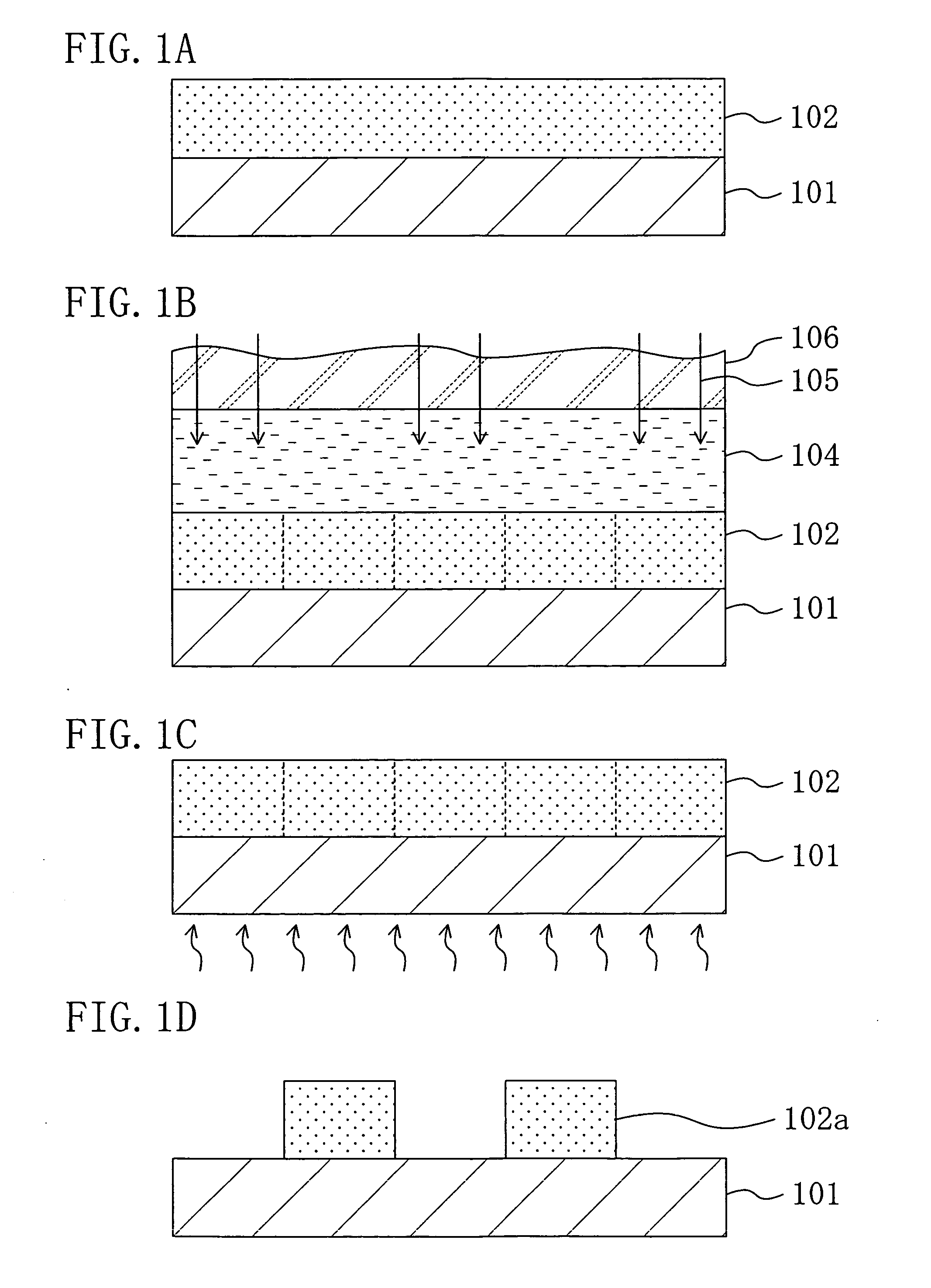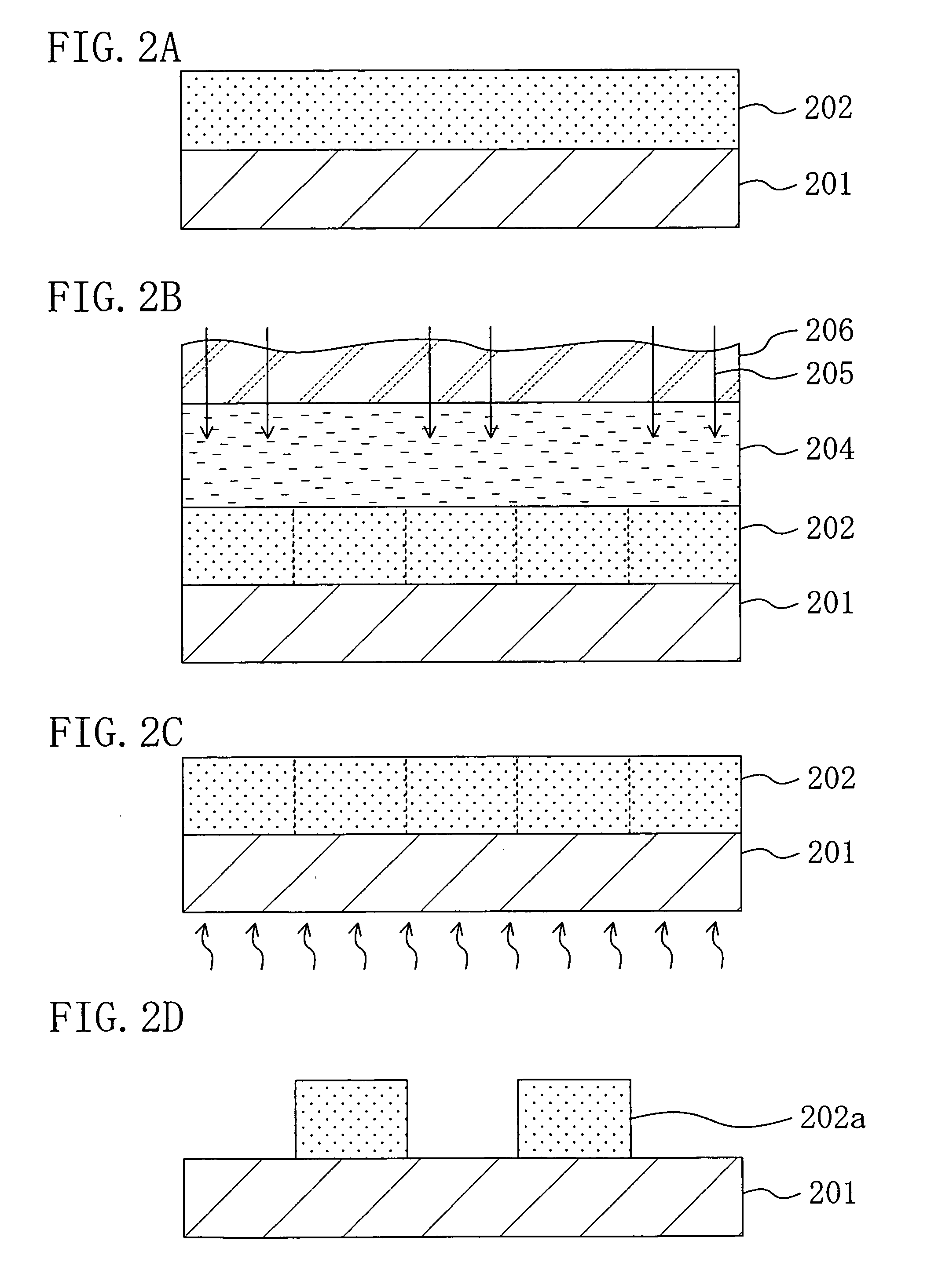Chemically amplified resist material and pattern formation method using the same
- Summary
- Abstract
- Description
- Claims
- Application Information
AI Technical Summary
Benefits of technology
Problems solved by technology
Method used
Image
Examples
embodiment 1
[0071] A pattern formation method according to Embodiment 1 of the invention will now be described with reference to FIGS. 1A through 1D.
[0072] First, a positive chemically amplified resist material having the following composition is prepared:
Base polymer: poly((norbornene-5-methylene hydroxymethyl2gcarboxylate) (50 mol %) - (maleic anhydride) (50 mol %))Acid generator: triphenylsulfonium trifluoromethane sulfonate0.04gQuencher: triethanolamine0.002gSolvent: propylene glycol monomethyl ether acetate20g
[0073] Next, as shown in FIG. 1A, the aforementioned chemically amplified resist material is applied on a substrate 101 so as to form a resist film 102 with a thickness of 0.35 μm.
[0074] Then, as shown in FIG. 1B, with an immersion liquid 104 of water provided between the resist film 102 and a projection lens 106 by, for example, a puddle method, pattern exposure is carried out by irradiating the resist film 102 through the liquid 104 with exposing light 105 of ArF excimer laser w...
embodiment 2
[0078] A pattern formation method according to Embodiment 2 of the invention will now be described with reference to FIGS. 2A through 2D.
[0079] First, a positive chemically amplified resist material having the following composition is prepared:
First base polymer: poly((norbornene-5-methylene2ghydroxyisopropyl carboxylate) (50 mol %) - (maleicanhydride) (50 mol %))Second base polymer: poly((norbornene-5-methylene0.08gmethoxymethyl carboxylate) (50 mol %) - (maleic anhydride)(50 mol %))Acid generator: triphenylsulfonium trifluoromethane sulfonate0.04gQuencher: triethanolamine0.002gSolvent: propylene glycol monomethyl ether acetate20g
[0080] Next, as shown in FIG. 2A, the aforementioned chemically amplified resist material is applied on a substrate 201 so as to form a resist film 202 with a thickness of 0.35 μm.
[0081] Then, as shown in FIG. 2B, with an immersion liquid 204 of water provided between the resist film 202 and a projection lens 206 by, for example, the puddle method, pat...
embodiment 3
[0087] A pattern formation method according to Embodiment 3 of the invention will now be described with reference to FIGS. 3A through 3D, 4A and 4B.
[0088] First, a positive chemically amplified resist material having the following composition is prepared:
Base polymer: poly((norbornene-5-methylene hydroxyethyl2gcarboxylate) (50 mol %) - (maleic anhydride) (50 mol %))Acid generator: triphenylsulfonium trifluoromethane sulfonate0.04gQuencher: triethanolamine0.002gSolvent: propylene glycol monomethyl ether acetate20g
[0089] Next, as shown in FIG. 3A, the aforementioned chemically amplified resist material is applied on a substrate 301 so as to form a resist film 302 with a thickness of 0.35 μm.
[0090] Then, as shown in FIG. 3B, by using a barrier film material having the following composition, a barrier film 303 having a thickness of 0.03 μm is formed on the resist film 302 by, for example, spin coating:
Base polymer: polyvinyl hexafluoroisopropyl alcohol 1 gSolvent: t-butyl alcohol2...
PUM
 Login to View More
Login to View More Abstract
Description
Claims
Application Information
 Login to View More
Login to View More - R&D
- Intellectual Property
- Life Sciences
- Materials
- Tech Scout
- Unparalleled Data Quality
- Higher Quality Content
- 60% Fewer Hallucinations
Browse by: Latest US Patents, China's latest patents, Technical Efficacy Thesaurus, Application Domain, Technology Topic, Popular Technical Reports.
© 2025 PatSnap. All rights reserved.Legal|Privacy policy|Modern Slavery Act Transparency Statement|Sitemap|About US| Contact US: help@patsnap.com



